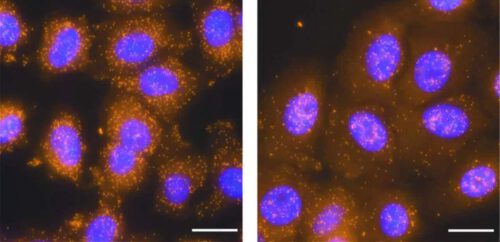
The "export" of RNA from the cell nucleus - a necessary process in the creation of proteins and the existence of life in a cell with a nucleus - was previously considered to be uniform and fast. In a new study Weizmann Institute of Science scientists have revealed that there are at least two routes for RNA export, and that the cell can inhibit certain RNA molecules in the nucleus, while others go out into the cell fluid in the fast and familiar route. The scientists showed that the existence of different export mechanisms may allow viruses to carry out selective silencing - to block the export of the RNA responsible for protection against viruses, without paralyzing the entire export and killing the cell that serves as their home. These findings shed new light on basic genetic mechanisms and may improve the understanding of viral infections.
"The textbooks teach that the export of almost all RNA molecules relies on the same cluster of genes, but we discovered that in human cells it is possible to distinguish at least two RNA export pathways and that a variety of pathways gives our cells - and viruses - the The possibility of paralyzing one of the routes in a selective manner", says Dr Igor Olitsky from the Department of Biological Control, who carried out the research with his students Benjamin Zuckerman and Maya Ron in collaboration with the post-doctoral researcher Dr. Martin Mikkel and Prof. Eran Segal from the Departments of Molecular Cell Biology and Computer Science and Applied Mathematics.
The production of RNA molecules in the cell nucleus is not a particularly fast process, but their export - the packaging of the molecules and their escort out into the cell fluid - usually lasts a few minutes. However, in recent years it has been discovered that sometimes instead of going out into the cell fluid and providing the necessary prescriptions for protein production, the RNA remains for a certain time in the nucleus, where it can perform other functions that are not necessarily related to protein production.

From the right: Benjamin Zuckerman, Dr. Igor Olitsky and Maya Ron. Export laws
To investigate this phenomenon, Dr. Olitsky and his colleagues selectively silenced the proteins responsible for RNA export in human cells. The scientists identified two groups of proteins that play different roles in export - these proteins "know" how to distinguish between RNA that is built from a small number of segments called exons and between RNA that is assembled from many exons (the number of exons in an RNA molecule can range from one to more than 100). The scientists discovered that one of the two groups of proteins, containing the protein NXF1, is mainly responsible for the export of RNA molecules that include no more than three exons, while the other group, TREX, focused on other RNA molecules that usually contain four or more exons . When the scientists silenced NXF1, the axon-poor RNA molecules got stuck in the nucleus, while when they silenced TREX, other RNA molecules got stuck in the nucleus.
The process of exon splicing probably evolved during evolution to help cells distinguish between their own RNA - which usually contains multiple exons - and the RNA of other viruses or invaders, which usually contains only one exon. The existence of two export pathways, which differ according to the number of exons, probably allows the cell flexibility in controlling RNA activity.
During the study, the scientists identified another mechanism that differentiates the two pathways: in order to be escorted out of the nucleus, axon-less RNA molecules must contain a well-folded segment that serves as a sort of "exit code" and can mark them as different from foreign RNA molecules or disturbed; Without this folded segment, the molecules get stuck without being able to get out of the cell nucleus and are prevented from producing proteins that could endanger the cell. Conversely, multi-exon RNA molecules, which usually belong to the cell itself and not to invaders, receive a "green light" to exit the nucleus without an exit "code", and therefore the chance of them getting stuck in the nucleus is lower.
Despite these mechanisms, it seems that the viruses have learned to use the separate pathways to their advantage. After entering the cell, they are able to block the export of axon-less RNA molecules that are responsible, among other things, for the prescriptions for the production of interferons - the body's first line of defense against viruses. This, without interfering with the export of multi-exon RNA molecules that ensures the continued existence of the host cell. This hypothesis was confirmed when the scientists analyzed data of RNA expression in human cells and saw that in cells that were exposed to viral proteins that inhibit RNA export, the molecules that were stuck in the nucleus were often few exons. This finding indicates that by selectively silencing RNA export, the viruses can indeed prevent the cell from producing proteins designed to fight the infection.
The number of RNA molecules in the cell fluid is usually 5 times greater than in the nucleus.
